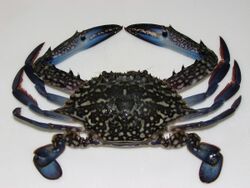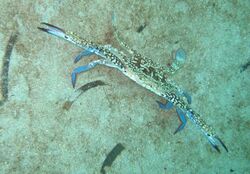Biology:Portunus pelagicus
| Portunus pelagicus | |
|---|---|

| |
| Male | |
| Scientific classification | |
| Domain: | Eukaryota |
| Kingdom: | Animalia |
| Phylum: | Arthropoda |
| Class: | Malacostraca |
| Order: | Decapoda |
| Suborder: | Pleocyemata |
| Infraorder: | Brachyura |
| Family: | Portunidae |
| Genus: | Portunus |
| Species: | P. pelagicus
|
| Binomial name | |
| Portunus pelagicus | |
| Synonyms | |
| |
Portunus pelagicus, also known as the blue crab, blue swimmer crab, blue manna crab and flower crab is a species of large crab found in the Indo-Pacific, including off the coasts Indonesia,[1] Malaysia,[2] Cambodia,[3] Thailand,[4] the Philippines,[5] and Vietnam;[6] and in the intertidal estuaries around most of Australia and east to New Caledonia.[7]
Description
The males are bright blue in color with white spots and with characteristically long chelipeds, while the females have a duller green/brown, with a more rounded carapace. The carapace can be up to 20 centimetres (7.9 in) wide.
Behaviour

They stay buried under sand or mud most of the time, particularly during the daytime and winter, which may explain their high tolerance to ammonium (NH4+) and ammonia (NH3).[8] They come out to feed during high tide on various organisms such as bivalves, fish and, to a lesser extent, macroalgae. They are excellent swimmers, largely due to a pair of flattened legs that resemble paddles. However, in contrast to another portunid crab (Scylla serrata), they cannot survive for long periods out of the water.
Capture
The species is commercially important throughout the Indo-Pacific, where they may be sold as traditional hard shells, or as "soft-shelled" crabs, which are considered a delicacy throughout Asia. The species is highly prized as a substitute for Callinectes sapidus. This species is fished heavily and almost exclusively for meat consumption in the Persian Gulf, with the females sold at higher prices than males.
These characteristics, along with their fast growth, ease of larviculture, high fecundity, and relatively high tolerance to both nitrate[9][10] and ammonia,[8] (particularly ammoniacal nitrogen, NH3–N, which is typically more toxic than ammonium, as it can more easily diffuse across the gill membranes), makes this species ideal for aquaculture.
The species is commercially fished in Australia, and is also available to recreational fishers and is regulated by various state governments. Relevant recreational fishing regulations for Australia (as of March 2016) are tabled below.
| State | Minimum carapace | Bag limit | Boat limit | Possession Limit | Notes |
|---|---|---|---|---|---|
| South Australia | 11 cm | 20 (Gulf St Vincent) or 40 (combined with sand crabs) | 60 (Gulf St Vincent) or 120 (combined with sand crabs) | N/A | [11] |
| New South Wales | 6 cm | 10 | N/A | 20 | [12] |
| Western Australia | 12.7 cm | 20 or 10 (West Coast) | 40 or 20 (West Coast) | N/A | Cockburn Sound is closed. Peel-Harvey Estuary is closed from 1 September to 31 October.[13][14] |
| Queensland | 11.5 cm | No limit | No limit | No limit | [15] |
| Northern Territory | N/A | N/A | N/A | 30 | Combined total for any crab species other than mud crabs.[16] |
Ecology

P. pelagicus commonly enters estuaries for food and shelter. Its life cycle is dependent on estuaries as the larvae and early juveniles use these habitats for growth and development. Prior to hatching, the female moves into shallow marine habitats, releases her eggs, and the newly-hatched zoea I larvae move into estuaries. During this time, they feed on microscopic plankton and progress from the zoea I stage to the zoea IV stage (approximately 8 days) and then to the final larval stage of megalopa (duration of 4–6 days). This larval stage is characterised by having large chelipeds used to catch prey. Once the megalopa metamorphoses to the crab stage, they continue to spend time in estuaries which provides a suitable habitat for shelter and food. However, evidence has shown that early juveniles cannot tolerate low salinities for extended periods, which is likely due to its weak hyper-osmoregulatory abilities.[17] This may explain their mass emigration from estuaries to seawater during the rainy season. Male Portunus pelagicus are believed to become more territorial in colder water. This may explain why male crabs are rarely sighted within a close proximity to each other in more temperate waters; it also may explain why their female counterparts seem more prolific in these areas.
References
- ↑ "FishSource - Blue swimming crab - Java Sea". https://www.fishsource.org/stock_page/742.
- ↑ "Saving flower crabs for future generations" (in en). https://www.thestar.com.my/metro/metro-news/2022/01/24/saving-flower-crabs-for-future-generations.
- ↑ "Enhancing sustainable management of the blue swimming crab fisheries in Cambodia". http://www.seafdec.org/enhancing-sustainable-management-blue-swimming-crab-fisheries-cambodia/.
- ↑ "Thai Blue Swimming Crab Fishery Improvement Project - a pathway to sustaining marine environment". https://wwf.panda.org/wwf_news/?228130/Thai-Blue-Swimming-Crab-Fishery-Improvement-Project---a-pathway-to-sustaining-marine-environments-and-local-livelihoods.
- ↑ "Wild-caught blue swimming crab in the Philippines". https://www.seafoodwatch.org/our-projects/wild-caught-crab-in-philippines#:~:text=The%20Philippines%20is%20the%20fourth,alternative%20to%20other%20crab%20products..
- ↑ "Research paper: Study of the impact of intermediaries on environmental and social outcomes and worker vulnerability in small-scale fishing and aquaculture in Indonesia and Viet Nam". 9 March 2021. https://www.ilo.org/jakarta/whatwedo/publications/WCMS_775003/lang--en/index.htm.
- ↑ Lai, Joelle C Y; Ng, Peter K L; Davie, Peter J F (2010). "A revision of the Portunus pelagicus (Linnaeus, 1758) species complex (Crustacea: Brachyura: Portunidae), with the recognition of four species". The Raffles Bulletin of Zoology 58 (2): 199–237. ISSN 0217-2445. https://www.researchgate.net/publication/228663959.
- ↑ 8.0 8.1 Nicholas Romano & Chaoshu Zeng (2007). "Ontogenetic changes in tolerance to acute ammonia exposure and associated histological alterations of the gill structure through the early juvenile development of the blue swimmer crab, Portunus pelagicus". Aquaculture 266: 246–254. doi:10.1016/j.aquaculture.2007.01.035.
- ↑ Nicholas Romano & Chaoshu Zeng (2007). "Acute toxicity of sodium nitrate, potassium nitrate and potassium chloride and their effects on the hemolymph composition and gill structure of early juvenile blue swimmer crabs (Portunus pelagicus Linnaeus, 1758) (Decapoda, Brachyura, Portunidae)". Environmental Toxicology and Chemistry 26 (9): 1955–1962. doi:10.1897/07-144R.1. PMID 17705664.
- ↑ Nicholas Romano & Chaoshu Zeng (2007). "Effects of potassium on nitrate mediated changes to osmoregulation in marine crabs". Aquatic Toxicology 85 (3): 202–208. doi:10.1016/j.aquatox.2007.09.004. PMID 17942166.
- ↑ "Blue Swimmer Crab" (in en-au). Department of Primary Industries and Regions, South Australia. http://pir.sa.gov.au/fishing/fishing_limits/blue_swimmer_crab.
- ↑ "Bag and size limits - saltwater - NSW Department of Primary Industries". http://www.dpi.nsw.gov.au/fisheries/recreational/regulations/sw/sw-bag-and-size.
- ↑ "Recreational fishing guide 2015". http://www.fish.wa.gov.au/documents/recreational_fishing/rec_fishing_guide/rules_guide_statewide.pdf.
- ↑ "Blue swimmer crab recreational fishing". http://www.fish.wa.gov.au/Species/Blue-Swimmer-Crabs/Pages/Blue-Swimmer-Crab-Recreational-Fishing.aspx.
- ↑ "Size, take and possession limits for tidal waters" (in en). https://www.daf.qld.gov.au/fisheries/recreational/rules-regulations/size-possession-limits-tidal.
- ↑ "Archived copy". http://www.nt.gov.au/d/Fisheries/Content/File/recreational/know-your-limits-booklet.pdf.
- ↑ Nicholas Romano & Chaoshu Zeng (2006). "The effects of salinity on the survival, growth and haemolymph osmolality of early juvenile blue swimmer crab, Portunus pelagicus". Aquaculture 260 (1–4): 151–162. doi:10.1016/j.aquaculture.2006.06.019.
External links
- Fisheries Western Australia - Blue Swimmer Crab Fact Sheet
- "Flower crabs, Portunus pelagicus". Online guide to Check Jawa. wildsingapore.com. 2003. http://www.wildsingapore.com/chekjawa/text/g321.htm.
- Leo W. H. Tan & Peter K. L. Ng (1988). "Flower crabs, Portunus pelagicus". Seashore Life in Singapore. http://mangrove.nus.edu.sg/pub/seashore/text/202.htm.
- Photos of Portunus pelagicus on Sealife Collection
Wikidata ☰ Q2364966 entry
 |

